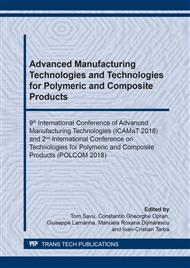[1]
Oanta, E., Panait, C., Aspects Regarding the Hybrid Models in Engineering, ModTech2013 Conf. Proc.
DOI: 10.4028/www.scientific.net/AMR.837.141
Google Scholar
[2]
A. Nita, B. Leitoiu, V. Goanta, P. Barsanescu, Measurements using the strain gage rosette in injection molded polymeric parts, Proc. of 11th Symposium Materials, Methods & Technologies (MM&T), Journal of International Scientific Publications: Materials, Methods & Technologies, www.science-journals.eu, ISSN 1313-2539 (2009) 34-45.
Google Scholar
[3]
A. Nita, E. Oanta, Multidisciplinary Studies Regarding the Residual Stress Minimization in Polymeric Injected Parts, MATERIALE PLASTICE, ISSN 0025-5289, 47 1 (2010) 69-73.
Google Scholar
[4]
On-line dictionary, http://www.dictionary.com/, accessed on October 7, (2018).
Google Scholar
[5]
3rd Hybrid Modeling Summer School, Hybrid modeling for process development, process characterization and optimization,, http://hybridmodeling.eu/, Vienna, Austria (2017).
Google Scholar
[6]
N. Munassar, A. Govardhan, Hybrid model for software development processes, 11th Intl. Arab Conf. on I.T. (2010).
Google Scholar
[7]
M. von Stosch, Hybrid Modeling: A Smart Way to Use All Available Knowledge, https://www.aiche.org/chenected/2014/02/hybrid-modeling-smart-way-use-all-available-knowledge, (2014).
Google Scholar
[8]
E. Oanta, B. Nicolescu, A Versatile PC-Based Method for the Processing of the Large Matrices, DETC99/CIE-9059, Proc. of the 19th Computers and Information in Engineering ASME Conf. (1999) 457-464.
DOI: 10.1115/detc99/cie-9059
Google Scholar
[9]
E. Oanta, I. Odagescu, I. Tamas, An original data processing method for cross-domain software applications, Bulletin of Transilvania, University of Brasov, Series B3–Economic Sciences, ISSN 1223-964X, 13 (48) (2006) 343-352.
Google Scholar
[10]
E. Oanta, A. Pescaru, A. Micu, Upgraded Original Automatic Interpolation Data Processor, Proc. of the ATOM-N 2018 Intl. Conf. (to be published).
DOI: 10.1117/12.2323169
Google Scholar
[11]
E. Oanta, A. Raicu, T. Axinte, A.E. Dascalescu, Technical Review Regarding the Methods to Formulate the Problems of the Factors Which Modify the Endurance Limit, Constanta Maritime University Annals, ISSN 1582-3601, XVI 23 (2015) 71-76.
Google Scholar
[12]
E. Oanță, V. C. Hreniuc, C. D. Grosu, Effective method used to create the analytical models of large sets of curves – application for the ship hull body plan, IOP Conference Series: Materials Science and Engineering, Volume 400, 4 - Characterization, Modeling and Simulation of Mechanical Processes, 042043, DOI https://doi.org/10.1088/1757-899X/400/4/042043 (2018).
DOI: 10.1088/1757-899x/400/4/042043
Google Scholar
[13]
E. Oanta, E. Constantinescu, A. Raicu, T. Axinte, Analytic General Solution Employed to Calculate the Geometrical Characteristics in Structural Problems, Advanced Materials Research 1036 (2014) 697-702.
DOI: 10.4028/www.scientific.net/amr.1036.697
Google Scholar
[14]
E. Oanta, A. Raicu, C. Panait, New Developments of the Computer Aided Analytical Definition of the Map-Wise Calculus Domains, IOP Conference Series: Materials Science and Engineering, Volume 444, Mechanics of Deformable Bodies, 062007, DOI https://doi.org/10.1088/1757-899X/444/6/062007 (2018).
DOI: 10.1088/1757-899x/444/6/062007
Google Scholar
[15]
E. Oanta, C. Panait, M. Barhalescu, A. Sabau, C. Dumitrache, A.E. Dascalescu, Original computer method for the experimental data processing in photoelasticity, Proc. SPIE 9258, Advanced Topics in Optoelectronics, Microelectronics, and Nanotechnologies VII, 92582A.
DOI: 10.1117/12.2070409
Google Scholar
[16]
E. Oanta, C. Panait, A. Raicu, Original data preprocessor for Femap/Nastran, Proc. SPIE 10010, Advanced Topics in Optoelectronics, Microelectronics, and Nanotechnologies VIII, 100102O.
DOI: 10.1117/12.2243000
Google Scholar
[17]
E. Oanta, C. Panait, G. Lazaroiu, A. Raicu, T. Axinte, A.E. Dascalescu, Conceiving a hybrid model of a weighting device, Proc. SPIE 9258, Advanced Topics in Optoelectronics, Microelectronics, and Nanotechnologies VII, 925829.
DOI: 10.1117/12.2069927
Google Scholar
[18]
A. Raicu, E. Oanta, A. Sabau, Making objective decisions in mechanical engineering problems, IOP Conference Series: Materials Science and Engineering 227.
DOI: 10.1088/1757-899X/227/1/012108
Google Scholar
[19]
E. Oanta, A. Raicu, C. Panait, Ideas for the rapid development of the structural models in mechanical engineering, IOP Conference Series: Materials Science and Engineering 227.
DOI: 10.1088/1757-899X/227/1/012084
Google Scholar
[20]
C. Panait, HORESEC project, Romanian Ministry of Research and Innovation, CCCDI-UEFISCDI, project number PN-III-P1-1.2-PCCDI-2017-04-04/31PCCDI/2018, within PNCDI III (2017).
DOI: 10.1016/j.ifacol.2017.08.1663
Google Scholar


